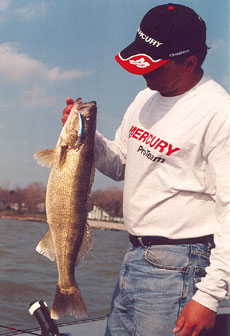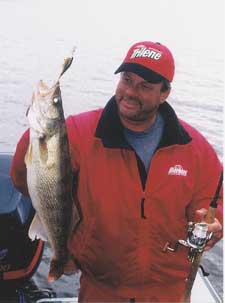
It’s a jungle out there.
Coontail, milfoil, waterweed and pondweed have shaken off the decay of winter and transformed the aquatic shallows into a living, breathing comfort zone for almost everything that lives in the underwater world.
Oxygen levels are high. Water temperatures are a few degrees warmer than they are offshore. Aquatic insects are coming to life, attracting baitfish and gamefish species like perch. Critters like crawdads and salamanders crawl among the plant roots.
It’s a smorgasboard for predator species like walleyes, bass and pike, which lurk in the shadows and use the cover of leafy submergent vegetation to ambush unsuspecting prey.
The draw to the weedy shallows is particularly strong for walleyes, which are eager to fatten up and heal up following the rigorous spawning ritual.
Along with the occasional northern pike or muskie, they are the kings of the beasts … Until you come along.
Early season weed fishing is a pattern that exists on nearly every body of water from lakes of all sizes to flowages, reservoirs and rivers. No matter where you go, walleyes relate to weeds. And while walleyes are typically my main course when I belly up to a salad bar, I’ll never complain about catching an occasional pike, bass or muskie in the process.
One of the things that makes weed fishing a great early season approach is accessibility. Most weeds grow close to shore, meaning that any angler can reach them.
You can cast to weeds from the bank, from a dock or from a pier. You can wade the shallows to reach many productive weed beds.
However, there are advantages to fishing weeds from a boat. With my Triton 215X, for example, I can cover far more areas than a shore angler, and I have the added dimension of being able to work the outside edges of the beds.
Of course, not all weed beds are created equal. I look for fairly dense vegetation in water 6 to 10 feet deep. I seek out weeds that have not yet reached the surface so I can work crankbaits over the tops of them. It’s also important to find weeds that are actively growing, and that usually means areas exposed to plenty of sun, but protected from heavy wave action that can uproot aquatic plants.
Crankbaits are a great way to explore these areas quickly and efficiently. Walleyes are the weeds for one primary reason – to eat. That means they are usually aggressive and willing to chase down a moving lure.
My go-to crankbait is a Normark Shad Rap, and my second choice would be a Rattlin’ Rap. They are baits that cast long and true even in moderate wind and imitate many of the species on which walleyes are in the weeds to eat. Long casts can be especially important because weeds tend to grow best in clear water and that usually means spooky fish.
I rely on my MinnKota 101 Maxum to quietly move my Triton around in the weeds and with battery power supplied by Optima, I can fish all day long without ever running short on power. If there’s a wind, work with it rather than against it to maximize your casting distance.
When the depth between the weeds and the surface allows, I use a standard No. 7 Shad Rap. When there isn’t as much room to work over the top of the vegetation, I’ll change to a shallow-running No. 7. If conditions dictate, I’ll downsize to a No. 5.
 One thing I like about the Rattlin’ Raps is they are a lipless crank where depth is totally controlled by rod position and the speed of the retrieve.
One thing I like about the Rattlin’ Raps is they are a lipless crank where depth is totally controlled by rod position and the speed of the retrieve.
The key to cranking the weed tops is ticking the weeds occasionally without getting constantly caught up in them. Rod control can help dictate depth to a degree. Simply hold your rod tip higher to make the bait run a little shallower or lower it to make it work a bit deeper.
That’s one of the reasons I like a 7-foot rod. I also like a medium or medium-heavy action because when I do pick up some vegetation on my crankbait, I can usually rip it loose with an aggressive snap of the rod.
For that same reason, a high-quality line is also important. Yo-Zuri’s Hybrid is a strong, dense fluorocarbon line with excellent abrasion resistance, high sensitivity that tells me when a bait isn’t running perfectly and low stretch that allows me to rip free from weeds but still have some give when fighting fish.
Crankbait patterns can vary from perch and firetiger that imitate perch to the clown, hot steel and chrome and blue that imitate other baitfish species. If you have multiple anglers in your party, make sure everyone is using something different until the fish tell you which one they prefer.
Once I’ve explored the surface over a weedbed, I use my Lowrance 111HD to pinpoint the weed edge, then try to line up my boat so I can stay in contact with that weed edge throughout my cast. Depending on how the weeds grow along a break, that could mean lining up at a 45-degree angle or a 90-degree angle. Sometimes, it means putting the boat right on the edge and casting parallel to shore along the edge.
Another presentation that can provide some fast and explosive action is slow-trolling spinner-and-crawler rigs on Off-Shore planer boards over the tops of the weeds.
Depending on the depth you have to work with, you can either troll them with no weight or with just a split shot or bullet weight and run them 50 feet or so behind the boards. Spinners tend to work through the weeds well, but keep an eye out for boards that seem to be dragging because that’s usually an indication that you’ve picked up some debris.
Some anglers are reluctant to fish crawler rigs over the weeds because of nuisance fish like perch, but it’s been my experience that when perch are giving me problems, there aren’t many walleyes in the area. If there were, the perch would be swimming for cover.
Jig fishing enthusiasts can get in on this jungle fever, too.
While you can swim jigs over the tops of the weeds, more often I use my MinnKota to get into the thickest vegetation I can find, then flip and pitch 1/16th- or 1/8th-ounce Lindy Vegi Jigs tipped with leeches, crawlers, minnows or Lindy Techni-Glo Munchies plastics into the pockets of open water.
It won’t take long to find out if there are walleyes in the area. They tend to be extremely aggressive when you find them, and you can often see them attack your jig as it sinks slowly out of sight. A good pair of polarized sunglasses will help enhance the visual experience.
Weed fishing for walleyes is a blast, and it’s an opportunity that exists almost everywhere in May. Whether you prefer to cast cranks, dabble jigs or troll rigs, there are plenty of hungry walleyes to be caught.
It’s up to you to show them who is the King of the Beasts.










